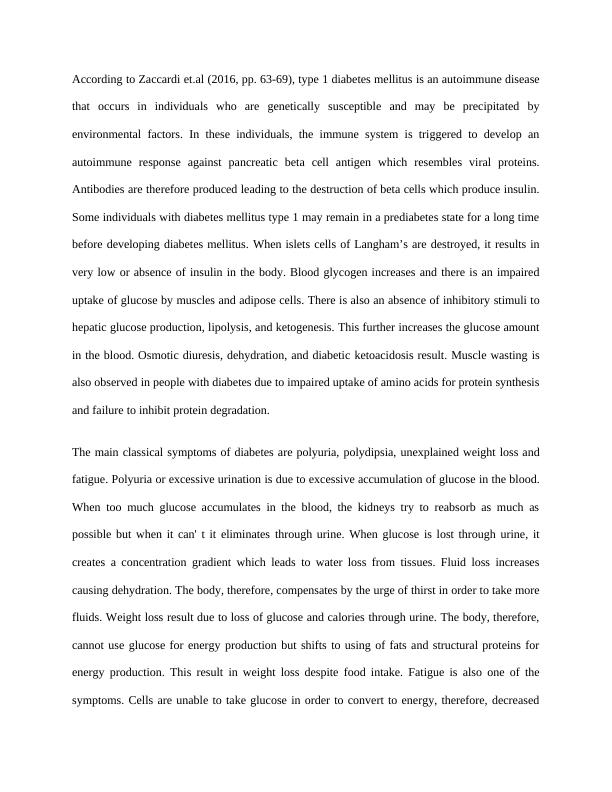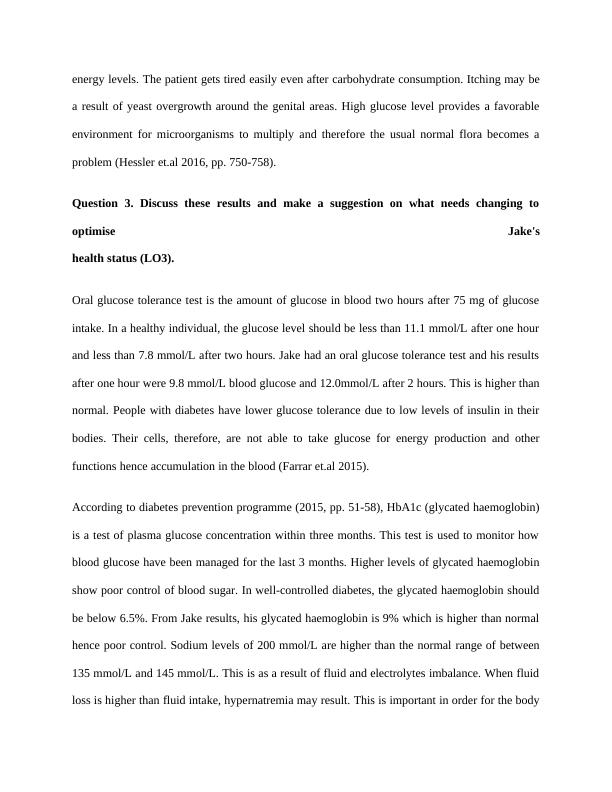Diabetes Mellitus Assignment (PDF)
Added on 2021-09-24
6 Pages1777 Words278 Views
Question 1. Comment on all results that are of concern (blood and urine) and offer a
diagnosis for Jake. You should represent and analyse this data appropriately (LO1).
Jake's laboratory results are not within the normal range. According to Rao and Raju (2016,
pp.2757-2761), random blood sugar of 22 mmol/L is higher than the normal random blood sugar
of 7.5 mmol/L in a healthy individual. This should not be the case in a normal individual because
insulin helps to lower blood sugar level by allowing movement of glucose from the blood to cells
for use. Glucose in urine of 28 mmol/ liter is also higher than the normal value of between 0 and
0.8 mmol/L (Gu et.al 2016, pp.7191-7197). This is because nearly all glucose is reabsorbed in
the proximal convoluted tubule of the kidney after being filtered by the glomerulus. This should,
therefore, lead to the absence or very little amount of glucose lost in urine. Jake has also been
going to the toilet more often than normal, a condition known as polyuria (Mahon.et.al 2018).
This is as a result of glucose loss in urine therefore, water follows passively leading to large
volumes of urine loss. He has also been feeling thirsty most of the time, a condition called
polydipsia (Coleman.et.al 2016). The patient has to take too many fluids to compensate for fluids
lost in urine. Basing on the signs and symptoms of Jake, a diagnosis of Diabetes mellitus type 1
can be made. This is due to the presence of polyuria, polydipsia, the presence of glucose in urine
and random blood sugar of 22 mmol/L. Type one diabetes is also of early onset.
Question 2. Discuss the pathophysiology underlying cellular changes that account for
Jake’s health status. You should also explain some of his signs/symptoms. (LO2).
Pathophysiology of type 1 diabetes mellitus
diagnosis for Jake. You should represent and analyse this data appropriately (LO1).
Jake's laboratory results are not within the normal range. According to Rao and Raju (2016,
pp.2757-2761), random blood sugar of 22 mmol/L is higher than the normal random blood sugar
of 7.5 mmol/L in a healthy individual. This should not be the case in a normal individual because
insulin helps to lower blood sugar level by allowing movement of glucose from the blood to cells
for use. Glucose in urine of 28 mmol/ liter is also higher than the normal value of between 0 and
0.8 mmol/L (Gu et.al 2016, pp.7191-7197). This is because nearly all glucose is reabsorbed in
the proximal convoluted tubule of the kidney after being filtered by the glomerulus. This should,
therefore, lead to the absence or very little amount of glucose lost in urine. Jake has also been
going to the toilet more often than normal, a condition known as polyuria (Mahon.et.al 2018).
This is as a result of glucose loss in urine therefore, water follows passively leading to large
volumes of urine loss. He has also been feeling thirsty most of the time, a condition called
polydipsia (Coleman.et.al 2016). The patient has to take too many fluids to compensate for fluids
lost in urine. Basing on the signs and symptoms of Jake, a diagnosis of Diabetes mellitus type 1
can be made. This is due to the presence of polyuria, polydipsia, the presence of glucose in urine
and random blood sugar of 22 mmol/L. Type one diabetes is also of early onset.
Question 2. Discuss the pathophysiology underlying cellular changes that account for
Jake’s health status. You should also explain some of his signs/symptoms. (LO2).
Pathophysiology of type 1 diabetes mellitus

According to Zaccardi et.al (2016, pp. 63-69), type 1 diabetes mellitus is an autoimmune disease
that occurs in individuals who are genetically susceptible and may be precipitated by
environmental factors. In these individuals, the immune system is triggered to develop an
autoimmune response against pancreatic beta cell antigen which resembles viral proteins.
Antibodies are therefore produced leading to the destruction of beta cells which produce insulin.
Some individuals with diabetes mellitus type 1 may remain in a prediabetes state for a long time
before developing diabetes mellitus. When islets cells of Langham’s are destroyed, it results in
very low or absence of insulin in the body. Blood glycogen increases and there is an impaired
uptake of glucose by muscles and adipose cells. There is also an absence of inhibitory stimuli to
hepatic glucose production, lipolysis, and ketogenesis. This further increases the glucose amount
in the blood. Osmotic diuresis, dehydration, and diabetic ketoacidosis result. Muscle wasting is
also observed in people with diabetes due to impaired uptake of amino acids for protein synthesis
and failure to inhibit protein degradation.
The main classical symptoms of diabetes are polyuria, polydipsia, unexplained weight loss and
fatigue. Polyuria or excessive urination is due to excessive accumulation of glucose in the blood.
When too much glucose accumulates in the blood, the kidneys try to reabsorb as much as
possible but when it can' t it eliminates through urine. When glucose is lost through urine, it
creates a concentration gradient which leads to water loss from tissues. Fluid loss increases
causing dehydration. The body, therefore, compensates by the urge of thirst in order to take more
fluids. Weight loss result due to loss of glucose and calories through urine. The body, therefore,
cannot use glucose for energy production but shifts to using of fats and structural proteins for
energy production. This result in weight loss despite food intake. Fatigue is also one of the
symptoms. Cells are unable to take glucose in order to convert to energy, therefore, decreased
that occurs in individuals who are genetically susceptible and may be precipitated by
environmental factors. In these individuals, the immune system is triggered to develop an
autoimmune response against pancreatic beta cell antigen which resembles viral proteins.
Antibodies are therefore produced leading to the destruction of beta cells which produce insulin.
Some individuals with diabetes mellitus type 1 may remain in a prediabetes state for a long time
before developing diabetes mellitus. When islets cells of Langham’s are destroyed, it results in
very low or absence of insulin in the body. Blood glycogen increases and there is an impaired
uptake of glucose by muscles and adipose cells. There is also an absence of inhibitory stimuli to
hepatic glucose production, lipolysis, and ketogenesis. This further increases the glucose amount
in the blood. Osmotic diuresis, dehydration, and diabetic ketoacidosis result. Muscle wasting is
also observed in people with diabetes due to impaired uptake of amino acids for protein synthesis
and failure to inhibit protein degradation.
The main classical symptoms of diabetes are polyuria, polydipsia, unexplained weight loss and
fatigue. Polyuria or excessive urination is due to excessive accumulation of glucose in the blood.
When too much glucose accumulates in the blood, the kidneys try to reabsorb as much as
possible but when it can' t it eliminates through urine. When glucose is lost through urine, it
creates a concentration gradient which leads to water loss from tissues. Fluid loss increases
causing dehydration. The body, therefore, compensates by the urge of thirst in order to take more
fluids. Weight loss result due to loss of glucose and calories through urine. The body, therefore,
cannot use glucose for energy production but shifts to using of fats and structural proteins for
energy production. This result in weight loss despite food intake. Fatigue is also one of the
symptoms. Cells are unable to take glucose in order to convert to energy, therefore, decreased

energy levels. The patient gets tired easily even after carbohydrate consumption. Itching may be
a result of yeast overgrowth around the genital areas. High glucose level provides a favorable
environment for microorganisms to multiply and therefore the usual normal flora becomes a
problem (Hessler et.al 2016, pp. 750-758).
Question 3. Discuss these results and make a suggestion on what needs changing to
optimise Jake's
health status (LO3).
Oral glucose tolerance test is the amount of glucose in blood two hours after 75 mg of glucose
intake. In a healthy individual, the glucose level should be less than 11.1 mmol/L after one hour
and less than 7.8 mmol/L after two hours. Jake had an oral glucose tolerance test and his results
after one hour were 9.8 mmol/L blood glucose and 12.0mmol/L after 2 hours. This is higher than
normal. People with diabetes have lower glucose tolerance due to low levels of insulin in their
bodies. Their cells, therefore, are not able to take glucose for energy production and other
functions hence accumulation in the blood (Farrar et.al 2015).
According to diabetes prevention programme (2015, pp. 51-58), HbA1c (glycated haemoglobin)
is a test of plasma glucose concentration within three months. This test is used to monitor how
blood glucose have been managed for the last 3 months. Higher levels of glycated haemoglobin
show poor control of blood sugar. In well-controlled diabetes, the glycated haemoglobin should
be below 6.5%. From Jake results, his glycated haemoglobin is 9% which is higher than normal
hence poor control. Sodium levels of 200 mmol/L are higher than the normal range of between
135 mmol/L and 145 mmol/L. This is as a result of fluid and electrolytes imbalance. When fluid
loss is higher than fluid intake, hypernatremia may result. This is important in order for the body
a result of yeast overgrowth around the genital areas. High glucose level provides a favorable
environment for microorganisms to multiply and therefore the usual normal flora becomes a
problem (Hessler et.al 2016, pp. 750-758).
Question 3. Discuss these results and make a suggestion on what needs changing to
optimise Jake's
health status (LO3).
Oral glucose tolerance test is the amount of glucose in blood two hours after 75 mg of glucose
intake. In a healthy individual, the glucose level should be less than 11.1 mmol/L after one hour
and less than 7.8 mmol/L after two hours. Jake had an oral glucose tolerance test and his results
after one hour were 9.8 mmol/L blood glucose and 12.0mmol/L after 2 hours. This is higher than
normal. People with diabetes have lower glucose tolerance due to low levels of insulin in their
bodies. Their cells, therefore, are not able to take glucose for energy production and other
functions hence accumulation in the blood (Farrar et.al 2015).
According to diabetes prevention programme (2015, pp. 51-58), HbA1c (glycated haemoglobin)
is a test of plasma glucose concentration within three months. This test is used to monitor how
blood glucose have been managed for the last 3 months. Higher levels of glycated haemoglobin
show poor control of blood sugar. In well-controlled diabetes, the glycated haemoglobin should
be below 6.5%. From Jake results, his glycated haemoglobin is 9% which is higher than normal
hence poor control. Sodium levels of 200 mmol/L are higher than the normal range of between
135 mmol/L and 145 mmol/L. This is as a result of fluid and electrolytes imbalance. When fluid
loss is higher than fluid intake, hypernatremia may result. This is important in order for the body

End of preview
Want to access all the pages? Upload your documents or become a member.
Related Documents
Module 2 Assignment: Immune System Disorderslg...
|6
|1647
|21
401014 - Health Variations Nursing - WSUlg...
|9
|2291
|80
Type 1 Diabetes Mellituslg...
|14
|3865
|284
Type 1 Diabetes: Case Study Analysis - 401007lg...
|9
|2354
|409
CNA255 Case Study: Diabetes Mellitus, Acute Kidney Injury, and Fertility Issueslg...
|8
|3688
|307
Nursing Intervention.lg...
|13
|2543
|2